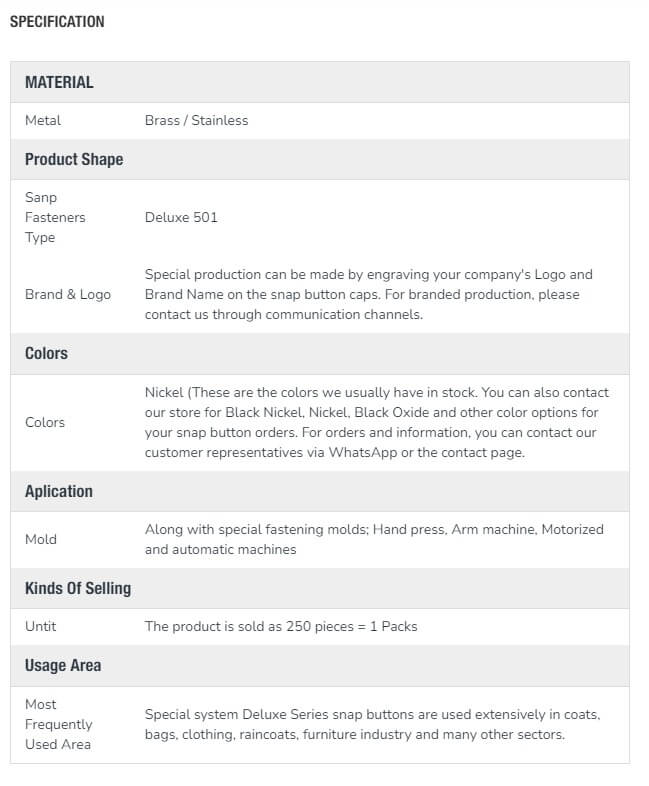Textile Accessories Material Guide: Brass, Stainless Steel, and Mild Steel
-1140x300w.webp)
Welcome, dear readers! We have prepared a comprehensive guide to help you navigate through the common material confusions encountered in textile accessories. This article explores brass, stainless steel, and mild steel in detail, discussing their advantages, disadvantages, and best uses in textile products.
Brass: Definition and Properties
Brass is an alloy composed of copper and zinc, known for its yellowish hue. It is prized for its aesthetic richness and can be electroplated in various colors, making it versatile for decorative purposes. Brass is corrosion-resistant and maintains its quality over time if properly cared for.
Stainless Steel: Definition and Properties
Stainless steel is an iron-based alloy primarily made with chromium, which provides excellent resistance to rust. It offers a sleek, modern look and is a cost-effective alternative in textile accessories due to its durability and aesthetic appeal.
Mild Steel: Definition and Properties
Mild steel, while functionally similar to other materials in shape and appearance, has a lower resistance to rust and is the most economical option available. However, it can degrade over time due to rust, which can compromise the integrity of your carefully designed products.
.jpg)
Comparative Analysis and Selection Criteria
When choosing between these materials, consider the following:
- Durability: Both brass and stainless steel offer excellent resistance to corrosion, whereas mild steel is prone to rusting.
- Aesthetic Preferences: Brass allows for a variety of colors through electroplating and suits products needing a classic look. Stainless steel provides a contemporary appeal, while mild steel is generally used for more functional, less aesthetic-focused products.
- Cost: Mild steel is the most cost-effective option, followed by stainless steel, which is generally less expensive than brass.
The Importance of Material Descriptions on E-Commerce Sites
Many e-commerce platforms fail to specify the materials used in products, leading consumers to believe they are purchasing high-quality items when they might be buying mild steel products that deteriorate quickly. Sites like E-button that clearly state product materials help consumers make informed choices.

Customer Support Services
If you are uncertain about the best material for your project or have questions about a product, you can contact us via WhatsApp, email, or phone on the E-button site. Our expert team is eager to assist you in making the most appropriate selection for your needs.
Conclusion
We hope this material guide aids you in choosing the most suitable material for your textile accessories, enhancing the quality and aesthetics of your projects. By selecting the right materials, you can increase customer satisfaction and extend the lifespan of your products.
Frequently Asked Questions (FAQs)
-
Do Brass and Stainless Steel Really Not Rust? Yes, when properly maintained, these materials do not rust. Brass is highly resistant to corrosion, and stainless steel’s high chromium content prevents rusting.
-
How Can I Extend the Life of Mild Steel Products? Keep mild steel items dry and away from moist environments to minimize rusting. Protective sprays can also help extend their lifespan.
-
What Information Can I Find on the E-button Site? Our site provides detailed descriptions, usage areas, and material information for our products, aiding customers in making the best possible choice for their needs.


-no5-k0010%20(3)-590x590.webp)



3 Comment(s)
Pirinç aksesuarlarımız her zaman müşterilerimiz tarafından beğeniliyor, sağlamlığı ve şık tasarımı ile ön plana çıkıyor
Yorum için Teşekkürler. Malzeme kalitesi önemlidir.
Saç demir ürünler, fiyatı uygun olması nedeniyle projelerimizde sıklıkla kullanıyoruz, fakat paslanma konusunda dikkatli olmak gerekiyor
Yorum için Teşekkürler. Özellikle küçük projeler üretenler.
Galvano kaplama sayesinde, pirinç ürünlerimiz her renkte parlıyor ve müşterilerimizin gözdesi oluyor.
Yorum için teşekkürler
Leave a Comment